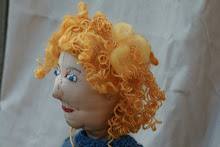- a picture of the garments included in the pattern--photos or drawings. The different options usually are indicated by a letter. In this case there are four styles of tops: A, B, C & D; and one style of pants: E.
- Brand name--duh--but as you get to know different patterns the brand name actually gives you lots of information.
- Pattern number: a lot of Pattern Companies put out catalogues from which you choose your pattern and then ask for the pattern number at the shop counter. I guess that saves a lot of display space in the shop and also prevents the patterns being knocked around since they're only made of paper, and often tissue paper at that.
- Price code--also duh--but some patterns cost as much as a ready made garment, so that is worth knowing.
- size range: most patterns include multiple sizes in the one envelope. In this case it's a whopping great 7 different sizes: 10-22. Often it's only 3 sizes and sometimes only 1. Sizes don't necessarily correspond with what you'd expect to buy in the shops, so that's something to check carefully.
OK, now here's the back of the pattern envelope:
Lots of information and it's worth knowing what it all means . . .
- on the far left we have line drawings of the different garments included in the pattern. If the pictures on the front are fancy photos or drawings that are a bit too "artistic" this gives you the nitty-gritty of the garment styles.
- the number of pattern pieces included. This will give you some idea of how complex the pattern is. In this case we have 5 styles and 16 pattern pieces. As it turns out when you look inside, the pants use only 2 main pattern pieces. That's a simple pattern. A friend of mine is currently working on a pair of shorts with 13 pattern pieces--not what I would call simple.
- the next column demonstrates one of those annoying idiosyncrasies of most patterns. They're in multiple languages: usually english plus spanish and/or french . . .
- and they're in both imperial and metric measurements
- but the english version is usually in imperial measurements--that's feet and inches. So if you're an english speaker who thinks in metric measurements, like me, you either need to multiply the inches by 2.5 to get cm, or figure out the what the metric measurements mean in a foreign language--choose your challenge!
- The bulk of this second column of information consists of size charts and fabric requirements. This tells you how much fabric you will need to make the various styles. They're often on the slightly generous side, but I would always rather have a bit too much than not enough fabric.
- There's usually also a list of suggested fabrics--more about this later
- and a list of "requirements" or "notions": things like buttons, elastic, zips, lace or whatever else you will need to finish off the garment.
- some patterns also include a written description of the garments. That might sound like overkill, but some of the information is really helpful. It might tell you about the amount of ease included in the design: is the garment fitted, semi-fitted or a loose-fit?
To cut a long story short: the pattern envelope aims to give you all the information you need to do your shopping: choose a style, size, fabric and any other bits and pieces you might need.


No comments:
Post a Comment